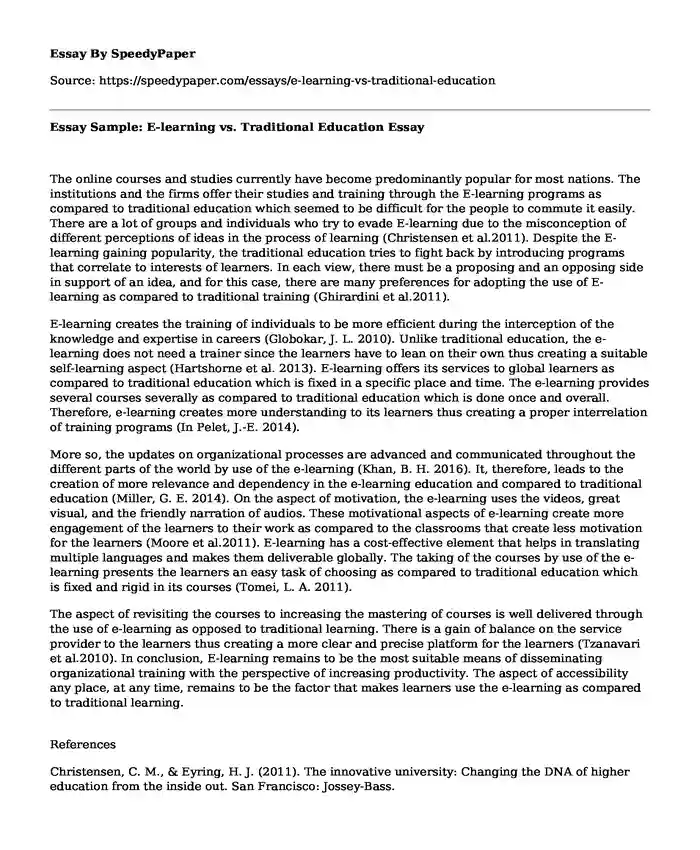The online courses and studies currently have become predominantly popular for most nations. The institutions and the firms offer their studies and training through the E-learning programs as compared to traditional education which seemed to be difficult for the people to commute it easily. There are a lot of groups and individuals who try to evade E-learning due to the misconception of different perceptions of ideas in the process of learning (Christensen et al.2011). Despite the E-learning gaining popularity, the traditional education tries to fight back by introducing programs that correlate to interests of learners. In each view, there must be a proposing and an opposing side in support of an idea, and for this case, there are many preferences for adopting the use of E-learning as compared to traditional training (Ghirardini et al.2011).
E-learning creates the training of individuals to be more efficient during the interception of the knowledge and expertise in careers (Globokar, J. L. 2010). Unlike traditional education, the e-learning does not need a trainer since the learners have to lean on their own thus creating a suitable self-learning aspect (Hartshorne et al. 2013). E-learning offers its services to global learners as compared to traditional education which is fixed in a specific place and time. The e-learning provides several courses severally as compared to traditional education which is done once and overall. Therefore, e-learning creates more understanding to its learners thus creating a proper interrelation of training programs (In Pelet, J.-E. 2014).
More so, the updates on organizational processes are advanced and communicated throughout the different parts of the world by use of the e-learning (Khan, B. H. 2016). It, therefore, leads to the creation of more relevance and dependency in the e-learning education and compared to traditional education (Miller, G. E. 2014). On the aspect of motivation, the e-learning uses the videos, great visual, and the friendly narration of audios. These motivational aspects of e-learning create more engagement of the learners to their work as compared to the classrooms that create less motivation for the learners (Moore et al.2011). E-learning has a cost-effective element that helps in translating multiple languages and makes them deliverable globally. The taking of the courses by use of the e-learning presents the learners an easy task of choosing as compared to traditional education which is fixed and rigid in its courses (Tomei, L. A. 2011).
The aspect of revisiting the courses to increasing the mastering of courses is well delivered through the use of e-learning as opposed to traditional learning. There is a gain of balance on the service provider to the learners thus creating a more clear and precise platform for the learners (Tzanavari et al.2010). In conclusion, E-learning remains to be the most suitable means of disseminating organizational training with the perspective of increasing productivity. The aspect of accessibility any place, at any time, remains to be the factor that makes learners use the e-learning as compared to traditional learning.
References
Christensen, C. M., & Eyring, H. J. (2011). The innovative university: Changing the DNA of higher education from the inside out. San Francisco: Jossey-Bass.
Ghirardini, B., & Organisation des Nations Unies pour l'alimentation et agriculture. (2011). E-learning methodologies: A guide for designing and developing e-learning courses. Rome: Food and Agriculture Organization of the United Nations.
Globokar, J. L. (2010). Introduction to online learning. London: Sage.
Hartshorne, R., Heafner, T. L., & Petty, T. M. (2013). Teacher education programs and online learning tools: Innovations in teacher preparation. Hershey, PA: Information Science Reference.
In Pelet, J.-E. (2014). E-learning 2.0 technologies and web applications in higher education.
Khan, B. H. (2016). Revolutionizing modern education through meaningful e-learning implementation.
Miller, G. E. (2014). Leading the e-learning transformation of higher education: Meeting the challenges of technology and distance education.
Moore, M. G., & Kearsley, G. (2011). Distance education: A systems view of online learning. Belmont, CA: Wadsworth Cengage Learning.
Tomei, L. A. (2011). Online courses and ICT in education: Emerging practices and applications. Hershey PA: Information Science Reference.
Tzanavari, A., Tsapatsoulis, N., & IGI Global. (2010). Affective, interactive and cognitive methods for e-learning design: Creating an optimal education experience. Hershey, PA: Information Science Reference.
Cite this page
Essay Sample: E-learning vs. Traditional Education. (2022, Nov 30). Retrieved from https://speedypaper.com/essays/e-learning-vs-traditional-education
Request Removal
If you are the original author of this essay and no longer wish to have it published on the SpeedyPaper website, please click below to request its removal:
- Reproductive system
- Work Stoppages in the Automotive Industry. Essay Example.
- Free HR Essay: Employee Training and Career Development Paper
- Business Essay Example: Organic Food-Boost Juice
- Essay Example: Job Interview with an Environmental Consultant
- Annotated Bibliography Example on Police Misconduct
- Essay Sample Focusing on the Future of Tourism in Hawaii
Popular categories





